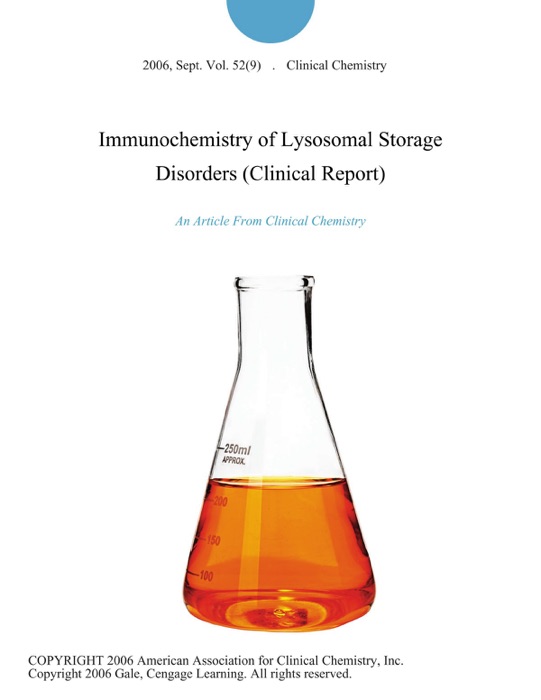(Download) "Immunochemistry of Lysosomal Storage Disorders (Clinical Report)" by Clinical Chemistry # Book PDF Kindle ePub Free

eBook details
- Title: Immunochemistry of Lysosomal Storage Disorders (Clinical Report)
- Author : Clinical Chemistry
- Release Date : January 01, 2006
- Genre: Chemistry,Books,Science & Nature,
- Pages : * pages
- Size : 205 KB
Description
Lysosomal storage disorders (LSDs) (1) are a group of more than 50 inherited diseases, which have a combined incidence of ~1:7700 live births (1). Each disorder is caused by the dysfunction of either a lysosomal enzyme or a lysosome-associated protein involved in enzyme activation, enzyme targeting, or lysosomal biogenesis. These defects lead to the accumulation of substrate that would normally be degraded in the endosome-lysosome system. In severely affected patients, this ultimately leads to the chronic and progressive deterioration of affected cells, tissues, and organs. Most LSDs display a broad spectrum of clinical manifestations, which have been previously identified as clinical subtypes [such as the Hurler/Scheie definition of mucopolysaccharidosis (MPS) I and the infantile-, juvenile-, and adult-onset forms of Pompe disease]. Some of the clinical symptoms that are observed in multiple LSDs (e.g., most of the MPSs) include bone abnormalities, organomegaly, coarse hair/fades, and central nervous system (CNS) dysfunction (2). At the severe end of the clinical spectrum, the onset of pathology tends to be rapid and progressive, whereas at the attenuated end, disease onset is later and progress less rapid. With the advent of molecular biology/genetics and the characterization of many of the genes associated with LSDs, it has now been recognized that the range of clinical severity may in part be ascribed to different disease-causing variations within the same gene. However, genotypephenotype correlations are not always informative (3). For example, in Gaucher disease, there are sometimes substantial differences in clinical manifestation between patients with the same genotype, and in some instances, one patient has been severely affected whereas another was virtually disease free (4). Other factors, including genetic background and environment, can also play a role in disease progression. The broad spectrum of clinical presentation in LSDs can make clinical diagnosis extremely difficult, taking months to years in some instances. Therapies, such as bone marrow or hematopoietic stem-cell transplantation and enzyme replacement therapy (ERT), are currently available for several LSDs, including MPS I (5, 6), MPS VI (7), Gaucher disease (8), and Fabry disease (9,10). Furthermore, clinical trials of ERT for MPS II (11) and Pompe disease (12) are in progress. Other strategies being developed include substrate deprivation (13-17), gene replacement (18-22), premature stop codon read-through (23), and chemical chaperone (24 26) therapies. The success of these treatment strategies in some cases (e.g., CNS pathology) may rely on the commencement of therapy before the pathology becomes irreversible. Recent progress toward newborn screening for LSDs holds promise for early detection (27-29). However, when patients are identified presymptomatically, decisions on the best therapeutic approach to apply will be difficult in the absence of a clinical prognosis. Accurate and sensitive methods are therefore required for the prediction of clinical phenotype, particularly the predisposition to CNS pathology. This review discusses immunochemical approaches that have been used to address the need for early detection, phenotype prediction, and characterization of the disease process in patients with LSDs.